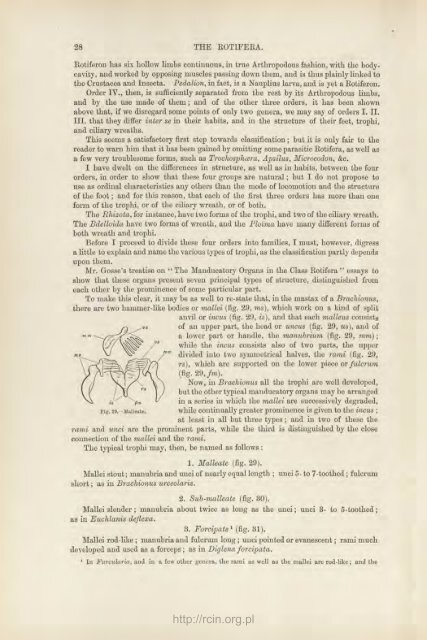You also want an ePaper? Increase the reach of your titles
YUMPU automatically turns print PDFs into web optimized ePapers that Google loves.
Rotiferon has six hollow limbs continuous, in true Artliropodous fashion, with <strong>the</strong> bodycavity,<br />
and worked by opposing muscles passing down <strong>the</strong>m, and is thus plainly linked to<br />
<strong>the</strong> Crustacea and Insecta. Pedalion, in fact, is a Nauplius larva, and is yet a Rotiferon.<br />
Order IV., <strong>the</strong>n, is sufficiently separated from <strong>the</strong> rest by its Artliropodous limbs,<br />
and by <strong>the</strong> use made of <strong>the</strong>m; and of <strong>the</strong> o<strong>the</strong>r three orders, it has been shown<br />
above that, if we disregard some points of only two genera, we may say of orders I. II.<br />
III. that <strong>the</strong>y differ inter se in <strong>the</strong>ir habits, and in <strong>the</strong> structure of <strong>the</strong>ir feet, trophi,<br />
and ciliary wreaths.<br />
This seems a satisfactory first step towards classification; but it is only fair to <strong>the</strong><br />
reader to warn him that it has been gained by omitting some parasitic Rotifera, as well as<br />
a few very troublesome forms, such as Trochosphcera, Apsilus, Microcodon, &c.<br />
I have dwelt on <strong>the</strong> differences in structure, as well as in habits, between <strong>the</strong> four<br />
orders, in order to show that <strong>the</strong>se four groups are natural; but I do not propose to<br />
use as ordinal characteristics any o<strong>the</strong>rs than <strong>the</strong> mode of locomotion and <strong>the</strong> structure<br />
of <strong>the</strong> foot; and for this reason, that each of <strong>the</strong> first three orders has more than one<br />
form of <strong>the</strong> trophi, or of <strong>the</strong> ciliary wreath, or of both.<br />
The Rliizota, for instance, have two forms of <strong>the</strong> trophi, and two of <strong>the</strong> ciliary wreath.<br />
The Bdelloida have two forms of wreath, and <strong>the</strong> Plo'ima have many different forms of<br />
both wreath and trophi.<br />
Before I proceed to divide <strong>the</strong>se four orders into families, I must, however, digress<br />
a little to explain and name <strong>the</strong> various types of trophi, as <strong>the</strong> classification partly depends<br />
upon <strong>the</strong>m.<br />
Mr. Gosse's treatise on " The Manducatory Organs in <strong>the</strong> Class Rotifera" essays to<br />
show that <strong>the</strong>se organs present seven principal types of structure, distinguished from<br />
each o<strong>the</strong>r by <strong>the</strong> prominence of some particular part.<br />
To make this clear, it may be as well to re-state that, in <strong>the</strong> mastax of a Brachionus,<br />
<strong>the</strong>re are two liammer-like bodies or mallei (fig. 29, ms), which work on a kind of split<br />
anvil or incus (fig. 29, is), and that each malleus consists<br />
of an upper part, <strong>the</strong> head or uncus (fig. 29, us), and of<br />
a lower part or handle, <strong>the</strong> manubrium (fig. 29, mm);<br />
while <strong>the</strong> incus consists also of two parts, <strong>the</strong> upper<br />
divided into two symmetrical halves, <strong>the</strong> rami (fig. 29,<br />
rs), which are supported on <strong>the</strong> lower piece or fulcrum<br />
(fig. 29, fm).<br />
Now, in Brachionus all <strong>the</strong> trophi are well developed,<br />
but <strong>the</strong> o<strong>the</strong>r typical manducatory organs may be arranged<br />
in a series in which <strong>the</strong> mallei are successively degraded,<br />
pig. 29.—Maiieate. while continually greater prominence is given to <strong>the</strong> incus ;<br />
at least in all but three types ; and in two of <strong>the</strong>se <strong>the</strong><br />
rami and unci are <strong>the</strong> prominent parts, while <strong>the</strong> third is distinguished by <strong>the</strong> close<br />
connection of <strong>the</strong> mallei and <strong>the</strong> rami.<br />
The typical trophi may, <strong>the</strong>n, be named as follows :<br />
1. Maiieate (fig. 29).<br />
Mallei stout; manubria and unci of nearly equal length ; unci 5- to 7-tootlied ; fulcrum<br />
short; as in Brachionus urceolaris.<br />
2. Sub-malleate (fig. 30).<br />
Mallei slender ; manubria about twice as long as <strong>the</strong> unci; unci 3- to 5-too<strong>the</strong>d;<br />
as in Euchlanis deflexa.<br />
3. Forcipate 1 (fig. 31).<br />
Mallei rod-like ; manubria and fulcrum long ; unci pointed or evanescent; rami much<br />
developed and used as a forceps; as in Diglena forcipata.<br />
1 In Furcularia, and in a few o<strong>the</strong>r genera, <strong>the</strong> rami as well as <strong>the</strong> mallei are rod-like; and <strong>the</strong><br />
http://rcin.org.pl
















